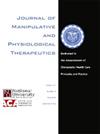Exercise Position to Improve Synergy Between the Diaphragm and Pelvic Floor Muscles in Women With Pelvic Floor Dysfunction: A Cross Sectional Study
IF 1.4
4区 医学
Q4 HEALTH CARE SCIENCES & SERVICES
Journal of Manipulative and Physiological Therapeutics
Pub Date : 2023-05-01
DOI:10.1016/j.jmpt.2024.02.005
引用次数: 0
Abstract
Objective
This study aimed to investigate the synergy between the diaphragm and pelvic floor muscles (PFM) according to different exercise positions in women with pelvic floor dysfunction. Our secondary aim was to determine the short-term effects of single-week pelvic floor muscle training (PFMT) program on diaphragmatic function.
Methods
The cross-sectional study included 64 women with pelvic floor dysfunction. The participants' diaphragm and abdominal muscle functions during voluntary PFM contraction and relaxation were assessed by surface electromyography and ultrasonography. The surface electromyography assessments were performed in supine (P1), crawling (P2) and sitting (P3) positions. A single week-PFMT was conducted on women who agreed to determine the short-term responses of the diaphragm function. The muscle functions according to exercise positions were compared with Friedman Analysis of Variance, and the short-term effects of single-week PFMT on diaphragm function was analyzed with Wilcoxon Signed-Ranks Test.
Results
The diaphragm activity during voluntary PFM contraction was highest in P2 before and after single-week PFMT (P < .001). Positive significant correlations were found between the activities diaphragm and abdominal muscles in different exercise positions (P < .05). After single-week PFMT, diaphragm thickness increased (P = .030) in P1, but diaphragm activity did not change in all 3 exercise positions (P > .05).
Conclusion
The synergy between the diaphragm and PFM was greater in the crawling position in women with pelvic floor dysfunction. The abdominal muscles seemed to contribute to maintaining this synergy. Therefore, PFMT combined with diaphragmatic breathing exercises in the crawling position should be considered. In addition, single-week PFMT may positively affect diaphragm function in the short-term.
改善盆底功能障碍妇女横膈膜与盆底肌肉协同作用的锻炼姿势:一项横断面研究。
研究目的本研究旨在调查患有盆底功能障碍的女性在不同运动姿势下横膈膜和盆底肌肉(PFM)之间的协同作用。我们的第二个目的是确定单周盆底肌肉训练(PFMT)计划对横膈膜功能的短期影响:这项横断面研究包括 64 名患有盆底功能障碍的女性。通过表面肌电图和超声波检查评估了参与者在盆底肌自主收缩和放松时的膈肌和腹肌功能。表面肌电图评估在仰卧位(P1)、爬行位(P2)和坐位(P3)进行。对同意测定膈肌功能短期反应的女性进行了单周膈肌功能测试。采用弗里德曼方差分析比较了不同运动姿势下的肌肉功能,并采用 Wilcoxon Signed-Ranks 检验分析了单周膈肌运动疗法对膈肌功能的短期影响:结果:单周膈肌功能训练前后,P2 在膈肌自主收缩时的活动量最大(P < .001)。不同运动姿势下的膈肌活动与腹肌活动之间存在正相关(P < .05)。单周横膈膜肌力训练后,P1 的横膈膜厚度增加(P = .030),但横膈膜的活动在所有 3 种运动姿势下均无变化(P > .05):结论:盆底功能障碍妇女在爬行姿势中横膈膜和盆底肌的协同作用更大。腹部肌肉似乎有助于维持这种协同作用。因此,应考虑在爬行姿势下将 PFMT 与横膈膜呼吸练习结合起来。此外,单周 PFMT 可能会在短期内对横膈膜功能产生积极影响。
本文章由计算机程序翻译,如有差异,请以英文原文为准。
求助全文
约1分钟内获得全文
求助全文
来源期刊
CiteScore
3.00
自引率
7.70%
发文量
63
审稿时长
29 weeks
期刊介绍:
The Journal of Manipulative and Physiological Therapeutics (JMPT) is an international and interdisciplinary journal dedicated to the advancement of conservative health care principles and practices. The JMPT is the premier biomedical publication in the chiropractic profession and publishes peer reviewed, research articles and the Journal''s editorial board includes leading researchers from around the world.
The Journal publishes original primary research and review articles of the highest quality in relevant topic areas. The JMPT addresses practitioners and researchers needs by adding to their clinical and basic science knowledge and by informing them about relevant issues that influence health care practices.

 求助内容:
求助内容: 应助结果提醒方式:
应助结果提醒方式:


